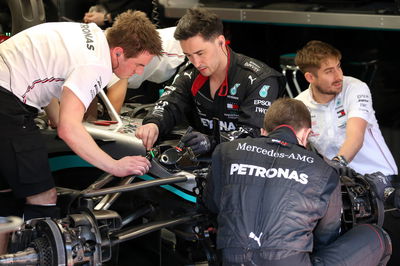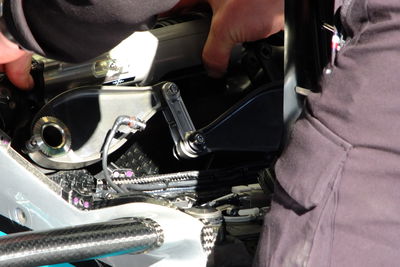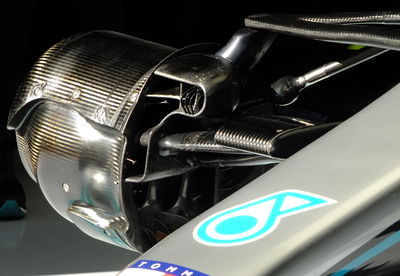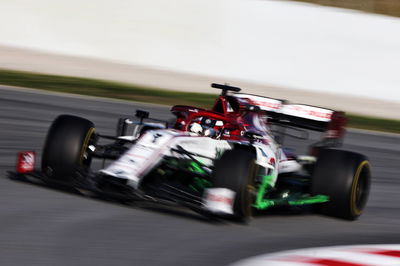How Mercedes turned heads with DAS steering wheel
Sometimes small details are impossible to hide, such is the case with the mysterious new system on the front suspension of the Mercedes W11 Formula 1 car.
During the second day of pre-season testing at Circuit de Barcelona-Catalunya it was noticed that Lewis Hamilton was pulling his steering wheel towards him at the start of straights and pushing it away at under braking.

Sometimes small details are impossible to hide, such is the case with the mysterious new system on the front suspension of the Mercedes W11 Formula 1 car.
During the second day of pre-season testing at Circuit de Barcelona-Catalunya it was noticed that Lewis Hamilton was pulling his steering wheel towards him at the start of straights and pushing it away at under braking.
This is not a case of a poorly mounted steering column moving under load, or a particularly aggressive driver, instead this is a deliberate piece of design and when the driver pulls or pushes the steering wheel the toe angle of the front wheels change with the movement.
Exactly why Mercedes is doing this is not fully clear and the team is not very forthcoming about the solution, simply describing it as a ‘steering mode.’
However, there is various speculation in the paddock that it is perhaps somehow to slightly change the ride height of the car or to reduce the rolling resistance of the tyres. A more compelling suggestion is that by increasing the toe angle on the straights the driver is able to keep the front tyres in the ideal window of operation, preventing them from cooling too much on the straights.
But, curiously, a counter rumour suggests that the system is designed to cool the tyres more on the straights.
Mercedes has been incredibly cagey about the purpose and functionality of the system, only revealing its name ‘DAS,’ which may stand for Dual-Axis Steering or perhaps Driver-Assisted Steering.
“We have a new system in the car, it’s a novel idea and it just introduces an extra dimension to the steering for the driver,” Mercedes Technical Director James Allison states. “We hope it will be useful during the year but how we use it, and why we use it, that we’ll keep to ourselves.”

Once it was spotted in operation there were, of course, questions about its legality, but Allison continued to it clear that he has no serious concerns about the system complying with the rules.
“I’m not really [concerned about legality]. This isn’t news to the FIA, we’ve been talking to them about it for some time. The rules are pretty clear about what’s prevented on steering systems and we’re pretty confident it matches all of those requirements.”
Some people have been quoting Article 10 of the 2020 Formula 1 technical regulations suggesting that the following two sections of it would make the DAS system illegal;
10.2.2 Any powered device which is capable of altering the configuration or affecting the performance of any part of any suspension system is forbidden.
10.2.3 No adjustment may be made to any suspension system while the car is in motion
However, neither of these lines really outlaw an unpowered system operated by the driver though the steering wheel. If this system were to be found to be a breach of 10.2.3 then the very act of steering the front wheels would also be a breach as the suspension moves as a result of the wheels moving.
Indeed, the FIA will have known about the systems existence and operation for quite some time, as the steering column itself has to pass a crash test, which will have been conducted at some point late last year. This test involves an 8kg projectile being fired into the column at 25kph or more, suggesting that the DAS system itself must be fairly robust.
“I’ve only had one morning and I don’t really have a lot to talk about with it,” Hamilton said, having completed 106 laps in the morning using the system at various stages of the session.
“We’re trying to get on top of it, understand it, but safety-wise no problem today and the FIA are okay with the project.”
The mechanical arrangements of the system have not been photographed or described, much to the frustration of rival teams but it is clear that there must be some linkages around the inboard front suspension which actually make the system work.

It appears to have two settings, both of which will be adjustable to give the exact toe angle required, but it is not clear if the driver can make these adjustments from the cockpit or if they have to be made when the car is in the garage. It is also not clear if the steering column itself is a constant length or if it has some telescopic sections.
Other teams will now be scrambling to evaluate their own versions of the system, but without clear images or information about how it works or even its exact purpose it is a process that could take them some significant time.
While its rivals are trying to work out what DAS actually is and how it works, Mercedes is hoping to reap its potential benefits.











